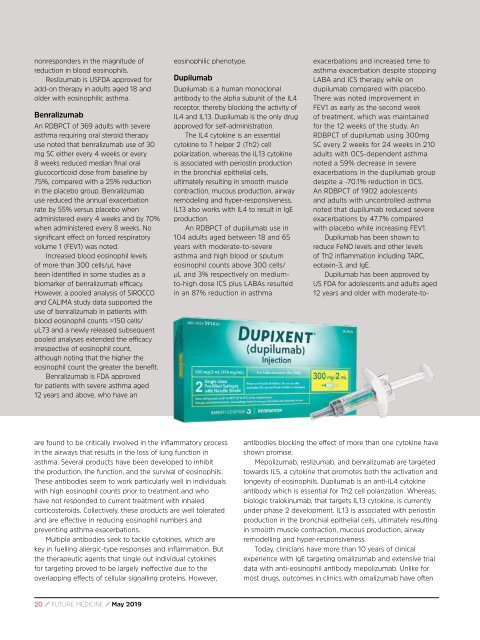may edition file
You also want an ePaper? Increase the reach of your titles
YUMPU automatically turns print PDFs into web optimized ePapers that Google loves.
slug<br />
nonresponders in the magnitude of<br />
reduction in blood eosinophils.<br />
Reslizumab is USFDA approved for<br />
add-on therapy in adults aged 18 and<br />
older with eosinophilic asthma.<br />
Benralizumab<br />
An RDBPCT of 369 adults with severe<br />
asthma requiring oral steroid therapy<br />
use noted that benralizumab use of 30<br />
mg SC either every 4 weeks or every<br />
8 weeks reduced median final oral<br />
glucocorticoid dose from baseline by<br />
75%, compared with a 25% reduction<br />
in the placebo group. Benralizumab<br />
use reduced the annual exacerbation<br />
rate by 55% versus placebo when<br />
administered every 4 weeks and by 70%<br />
when administered every 8 weeks. No<br />
significant effect on forced respiratory<br />
volume 1 (FEV1) was noted.<br />
Increased blood eosinophil levels<br />
of more than 300 cells/µL have<br />
been identified in some studies as a<br />
biomarker of benralizumab efficacy.<br />
However, a pooled analysis of SIROCCO<br />
and CALIMA study data supported the<br />
use of benralizumab in patients with<br />
blood eosinophil counts =150 cells/<br />
µL73 and a newly released subsequent<br />
pooled analyses extended the efficacy<br />
irrespective of eosinophil count,<br />
although noting that the higher the<br />
eosinophil count the greater the benefit.<br />
Benralizumab is FDA approved<br />
for patients with severe asthma aged<br />
12 years and above, who have an<br />
eosinophilic phenotype.<br />
Dupilumab<br />
Dupilumab is a human monoclonal<br />
antibody to the alpha subunit of the IL4<br />
receptor, thereby blocking the activity of<br />
IL4 and IL13. Dupilumab is the only drug<br />
approved for self-administration.<br />
The IL4 cytokine is an essential<br />
cytokine to T helper 2 (Th2) cell<br />
polarization, whereas the IL13 cytokine<br />
is associated with periostin production<br />
in the bronchial epithelial cells,<br />
ultimately resulting in smooth muscle<br />
contraction, mucous production, airway<br />
remodeling and hyper-responsiveness.<br />
IL13 also works with IL4 to result in IgE<br />
production.<br />
An RDBPCT of dupilumab use in<br />
104 adults aged between 18 and 65<br />
years with moderate-to-severe<br />
asthma and high blood or sputum<br />
eosinophil counts above 300 cells/<br />
µL and 3% respectively on mediumto-high<br />
dose ICS plus LABAs resulted<br />
in an 87% reduction in asthma<br />
exacerbations and increased time to<br />
asthma exacerbation despite stopping<br />
LABA and ICS therapy while on<br />
dupilumab compared with placebo.<br />
There was noted improvement in<br />
FEV1 as early as the second week<br />
of treatment, which was maintained<br />
for the 12 weeks of the study. An<br />
RDBPCT of dupilumab using 300mg<br />
SC every 2 weeks for 24 weeks in 210<br />
adults with OCS-dependent asthma<br />
noted a 59% decrease in severe<br />
exacerbations in the dupilumab group<br />
despite a -70.1% reduction in OCS.<br />
An RDBPCT of 1902 adolescents<br />
and adults with uncontrolled asthma<br />
noted that dupilumab reduced severe<br />
exacerbations by 47.7% compared<br />
with placebo while increasing FEV1.<br />
Dupilumab has been shown to<br />
reduce FeNO levels and other levels<br />
of Th2 inflammation including TARC,<br />
eotaxin-3, and IgE.<br />
Dupilumab has been approved by<br />
US FDA for adolescents and adults aged<br />
12 years and older with moderate-to-<br />
are found to be critically involved in the inflammatory process<br />
in the airways that results in the loss of lung function in<br />
asthma. Several products have been developed to inhibit<br />
the production, the function, and the survival of eosinophils.<br />
These antibodies seem to work particularly well in individuals<br />
with high eosinophil counts prior to treatment and who<br />
have not responded to current treatment with inhaled<br />
corticosteroids. Collectively, these products are well tolerated<br />
and are effective in reducing eosinophil numbers and<br />
preventing asthma exacerbations.<br />
Multiple antibodies seek to tackle cytokines, which are<br />
key in fuelling allergic-type responses and inflammation. But<br />
the therapeutic agents that single out individual cytokines<br />
for targeting proved to be largely ineffective due to the<br />
overlapping effects of cellular signalling proteins. However,<br />
antibodies blocking the effect of more than one cytokine have<br />
shown promise.<br />
Mepolizumab, reslizumab, and benralizumab are targeted<br />
towards IL5, a cytokine that promotes both the activation and<br />
longevity of eosinophils. Dupilumab is an anti-IL4 cytokine<br />
antibody which is essential for Th2 cell polarization. Whereas,<br />
biologic tralokinumab, that targets IL13 cytokine, is currently<br />
under phase 2 development. IL13 is associated with periostin<br />
production in the bronchial epithelial cells, ultimately resulting<br />
in smooth muscle contraction, mucous production, airway<br />
remodelling and hyper-responsiveness.<br />
Today, clinicians have more than 10 years of clinical<br />
experience with IgE targeting omalizumab and extensive trial<br />
data with anti-eosinophil antibody mepolizumab. Unlike for<br />
most drugs, outcomes in clinics with omalizumab have often<br />
20 / FUTURE MEDICINE / May 2019


















